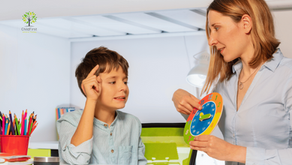10 Strategies for Establishing Healthy Sleep Habits in Kids with Autism
- ChildFirst Behavior Therapy
- Jan 5, 2024
- 6 min read

Sleep is crucial for a child's development, influencing their physical health, cognitive function, and emotional well-being. However, achieving restful sleep can be challenging for some children on the autism spectrum. Sleep disturbances and irregular patterns may affect their sleep quality, daily functioning, and behavior. Establishing healthy sleep habits in children with autism demands a multifaceted approach that considers their unique needs and challenges, often encompassing strategies derived from ABA family therapy.
Factors Contributing to the Sleep Challenges
Before exploring the strategies, it's essential to understand why a child might be having issues going to sleep. Many factors contribute to their sleep difficulties, including irregular melatonin production, anxiety, and challenges in understanding and following sleep routines. Recognizing these challenges is the first step in developing effective strategies tailored to each child's needs.
Let’s delve deeper into ten effective strategies to foster better sleep patterns in kids with autism:
Consistent Bedtime Routine
By engaging in these calming activities consistently, children with autism can develop a sense of security and relaxation, potentially reducing anxiety around bedtime. Additionally, incorporating activities that resonate with their interests or preferences can further enhance the effectiveness of the bedtime routine. It's essential to adapt and tailor the routine based on your child's responses and needs, ensuring it remains a soothing and enjoyable experience that promotes better sleep. Regularly evaluating and adjusting the exercise can help optimize its effectiveness in aiding their bedtime preparation.
Creating a Sleep-Friendly Environment
Crafting a sleep-conducive environment involves not just physical adjustments but also considering preferences. For instance, exploring weighted blankets or soft textures might provide a comforting feeling, promoting a sense of security conducive to sleep. Tailoring the environment to your child's needs can significantly impact their comfort and relaxation, paving the way for improved sleep quality. Regularly assessing and adapting the sleep environment based on your child's responses ensures it remains a supportive and tranquil space for restorative sleep.
Maintaining a Regular Sleep Schedule

A regular sleep schedule not only aids in falling asleep but also contributes to overall stability in mood and behavior for children with autism. It's crucial to reinforce this schedule consistently, as disruptions can affect the body's natural rhythm. Moreover, maintaining a consistent routine provides a sense of predictability, which is particularly comforting for children on the autism spectrum, fostering a more secure and stable sleep pattern. Regularity in sleep-wake times can be pivotal in supporting their daily functioning and enhancing their overall well-being.
Limiting Screen Time
Reducing screen time before bed is crucial for children with autism due to the impact of blue light on melatonin production, which regulates sleep. Substituting screen use with calming activities like reading or enjoying soft music not only aids in winding down but also promotes a peaceful bedtime routine. This shift away from screens fosters a tranquil environment that encourages relaxation, setting the stage for a more restful night's sleep for children on the autism spectrum.
Addressing Individual Needs
Trying different bedding materials, pajamas, or blankets allows for personalization based on what feels most soothing for your child. Finding the right textures or fabrics can significantly enhance their comfort, promoting relaxation and aiding in establishing a bedtime routine that caters to their receptive needs. Adapting the sleep environment to suit their preferences fosters a sense of security, contributing to better sleep quality.
Encouraging Physical Activity
Incorporating daily physical activities is beneficial for kids, allowing them to channel their energy and potentially improving their sleep patterns. Engaging in activities they enjoy, such as playground games, swimming, or walks, not only promotes physical health but can also positively impact their sleep quality. However, it's important to schedule these activities earlier in the day to avoid overstimulation closer to bedtime. Balancing physical exertion with adequate rest periods can support a smoother transition to a calmer state before sleep, contributing to better overall rest for children on the autism spectrum.
Teaching Relaxation Techniques
Implementing relaxation techniques like deep breathing or gentle stretches can assist children with autism in unwinding before bedtime, promoting a more tranquil state of mind conducive to sleep. Additionally, introducing mindfulness exercises fosters self-awareness, aiding in the release of tension and anxiety. Consistent practice of these techniques establishes a calming routine, empowering children with practical tools to ease into sleep more comfortably. Tailoring these techniques to match their preferences and receptive needs further enhances their effectiveness in preparing for a restful night's sleep.
Monitoring Diet and Nutrition
Keeping an eye on your child's dietary habits is vital, as specific foods or beverages can influence their sleep quality. Limiting caffeine intake, especially in the afternoon or evening, helps prevent its stimulating effects that could interfere with bedtime. Additionally, regulating meal times ensures that heavy or refreshing foods are consumed well before bedtime, promoting digestion and preventing discomfort that might disrupt sleep. By maintaining a balanced and timed diet, you can support your child's efforts in establishing a consistent and restful sleep routine.
Seeking Professional Guidance
Seeking guidance from healthcare professionals specializing in autism or sleep disorders is crucial for addressing unique sleep challenges in children with ASD. These professionals can conduct thorough assessments to identify underlying issues impacting sleep and provide personalized strategies or therapies. By collaborating with experts, you gain access to tailored interventions that target specific concerns, such as irregular sleep patterns to improve your child's sleep quality. Their expertise offers invaluable support in navigating the complexities of sleep-related issues in children with autism, ensuring a holistic and informed approach to enhancing their sleep habits.
Patience and Persistence

Building healthy sleep habits for children with autism requires dedication and persistence. Consistency in applying these strategies is critical, but it's equally important to remain flexible and adaptable. Keep a keen eye on your child's response to different approaches, adjusting the strategies to align with their preferences and comfort. Patience is essential; progress might be gradual, but each step forward is a significant achievement. Embracing the uniqueness of your child and tailoring strategies accordingly is fundamental in fostering a sleep routine that suits their individual needs and promotes their well-being.
Conclusion
Incorporating these strategies into your child's routine may significantly enhance their sleep quality and overall well-being. For more personalized guidance and expert support in navigating your child's unique needs, reach out to our team at ChildFirst Behavior Therapy for tailored interventions and comprehensive assistance for your child on the autism spectrum. We offer a spectrum of interventions, including behavior therapy, speech therapy, and occupational therapy, uniquely tailored to meet each child's individual needs.
FAQs
Why do children with autism often face challenges with sleep?
Sleep challenges in children with autism can be attributed to factors such as irregular melatonin production, anxiety, and difficulties in understanding and following sleep routines. Recognizing these challenges is crucial in developing effective sleep strategies.
How can a consistent bedtime routine benefit children with autism?
A consistent bedtime routine can provide a sense of security and relaxation for children with autism, potentially reducing anxiety around bedtime. Engaging in calming activities consistently and adapting the routine based on the child's responses fosters a soothing and enjoyable experience that promotes better sleep.
Why is a sleep-friendly environment important for children on the autism spectrum?
Crafting a sleep-conducive environment involves physical adjustments and considering the child's preferences. Tailoring the environment to their needs significantly impacts comfort and relaxation, contributing to improved sleep quality. Regular assessment and adaptation maintain a supportive and tranquil space for restorative sleep.
How does maintaining a regular sleep schedule contribute to overall stability for children with autism?
A regular sleep schedule not only aids in falling asleep but also contributes to stability in mood and behavior for children with autism. Consistent reinforcement of the schedule provides predictability, fostering a more secure and stable sleep pattern that supports daily functioning and overall well-being.
Why is it important to limit screen time for children with autism before bedtime?
Reducing screen time before bedtime is crucial due to the impact of blue light on melatonin production, which regulates sleep. Substituting screens with calming activities promotes a tranquil bedtime routine, creating an environment that encourages relaxation and sets the stage for a more restful night's sleep.
How can parents address individual needs when establishing sleep habits for their child with autism?
Addressing individual needs involves trying different bedding materials, pajamas, or blankets based on the child's preferences. Personalizing the sleep environment to suit their preferences fosters a sense of security, contributing to better sleep quality.
Why is physical activity important for children with autism in the context of sleep?
Incorporating daily physical activities allows children to channel their energy and potentially improve sleep patterns. Engaging in activities they enjoy promotes physical health and can positively impact sleep quality. It's crucial to schedule these activities earlier in the day to avoid overstimulation closer to bedtime.
What role do relaxation techniques play in helping children with autism unwind before bedtime?
Relaxation techniques, such as deep breathing and gentle stretches, assist children with autism in unwinding before bedtime. Introducing mindfulness exercises fosters self-awareness, aiding in the release of tension and anxiety. Consistent practice establishes a calming routine, empowering children with practical tools to ease into sleep more comfortably.
When should parents consider seeking professional guidance for their child's sleep issues?
Parents should consider seeking professional guidance from healthcare professionals specializing in autism or sleep disorders when facing persistent sleep challenges. These professionals can conduct thorough assessments, identify underlying issues, and provide personalized strategies or therapies tailored to improve the child's sleep quality.




Коментарі